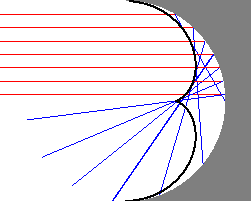

In general, suppose we have a family of curves C
However, when F(t,x,y) is a polynomial function of
all 3 variables t,x,y, there is a way to use elimination of
variables to compute the equation of a curve containing an
envelope to the family Ct. This is explained in
Projection, profiles, envelopes.
The idea goes like this. The equation F(t,x,y)=0 defines a
surface in 3-dimensional (x,y,t)-space.
In the case of our family of reflected line this surface
is built geometrically as a "ruled surface" by stacking up each
reflected light ray in sequence. Click here to see an
MPEG movie (478 Kbytes) of this process.
Of course, the complete surface is not merely the union of the
reflected rays that come in from the left (as in Figure 5),
but also includes the union of rays that reflect off the
left-hand side of the coffee cup.
As explained in
Projection, profiles, envelopes,
the points of the envelope are the projections onto the
xy-plane of those points on this surface F(t,x,y)=0 for which the
tangent plane is parallel to the t-axis. This leads us
to look for the equation of the envelope curves by
eliminating the variable t from the equations
In order to do this for our family of reflected lines Ct, we
must first express their equations in the form F(t,x,y) = 0,
i.e. we must get rid of the square root occurring in the equation
that we already found, and then bring all the terms to one side.
F(t,x,y) = ((y-t)(2-t2) + t(4-t2))2
- t2x2(4-t2)
F(t,x,y) = 0
d/dt F(t,x,y) = 0
Question 6
Using Maple, we can eliminate the t variable
via the following computation:
> F:=((y-t)*(2-t^2)+t*(4-t^2))^2-t^2*x^2*(4-t^2);
2 2 2 2 2 2
F := ((y - t) (2 - t ) + t (4 - t )) - t x (4 - t )
> GB:=gbasis({F,diff(F,t)},[t,x,y],plex):
Only one polynomial (the 9th and last) in the resulting Gröbner basis does
not involve the variable t, so this gives the equation for the envelope:
> factor(GB[9]);
2 2 2 2 4 2 2 4 6 4 2
x y (- 4 + 12 x - 15 y - 12 x - 24 x y - 12 y + 4 x + 12 x y
4 2 6
+ 12 y x + 4 y )
Question 7
How does this compare with the equation for the nephroid
we computing from the parametrization? What extra factors
show up in the envelope computation?
Next:
Conclusions
Previous:
The Geometry of Reflecting Light Rays
Up: Introduction
Vic Reiner <reiner@math.umn.edu>
Frederick J. Wicklin <fjw@geom.umn.edu>
Last modified: Tue Apr 16 07:43:57 1996